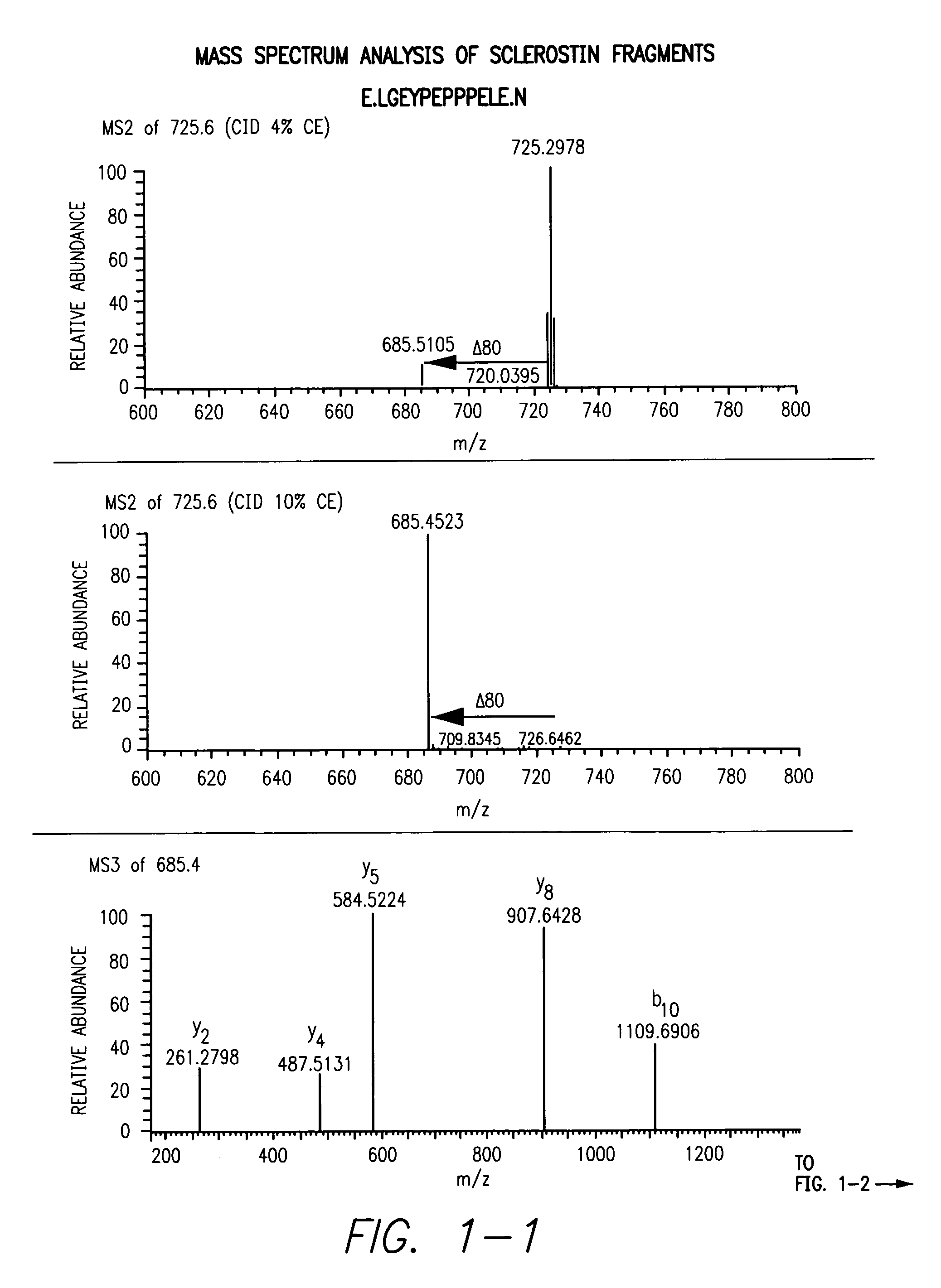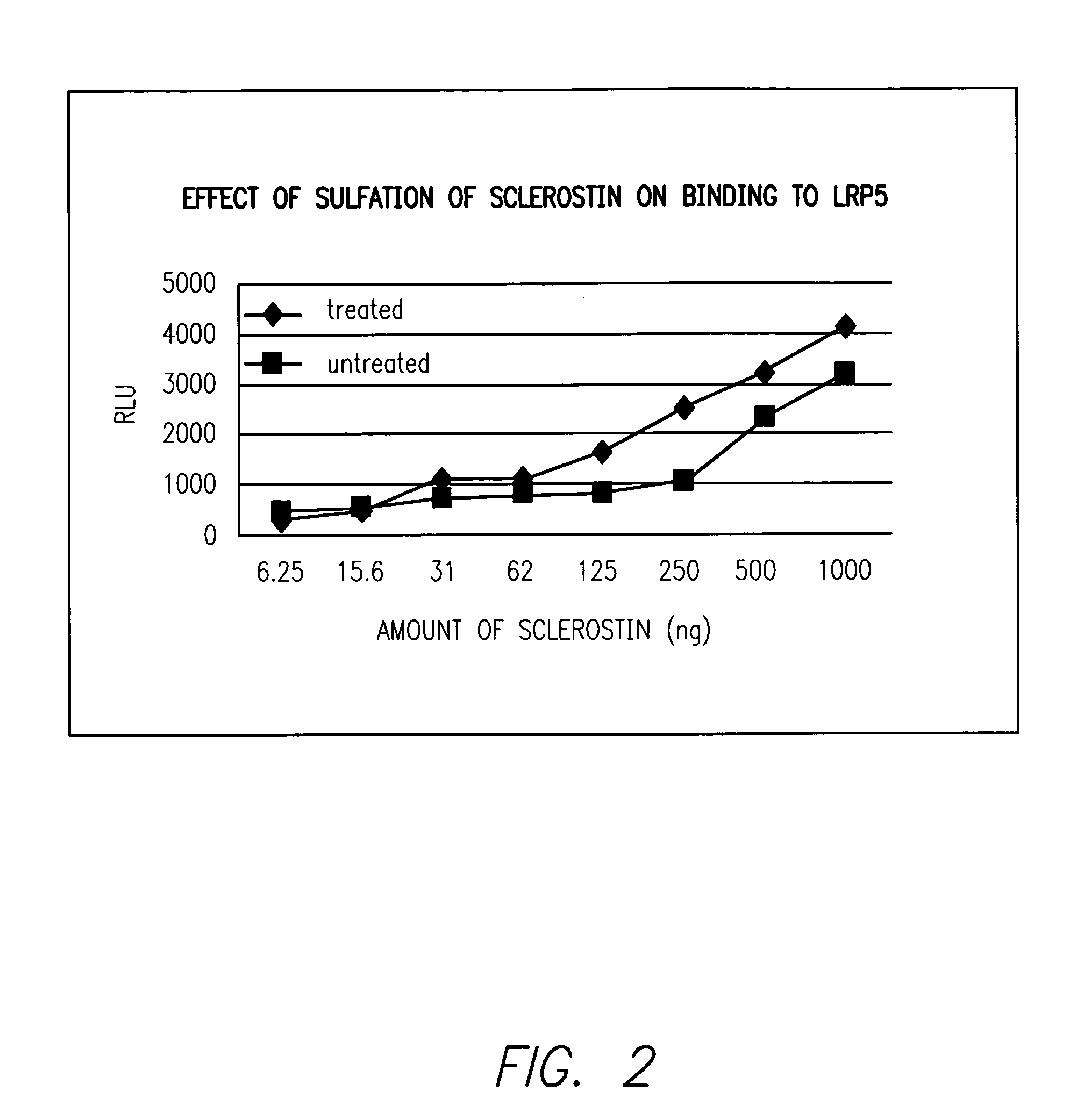Sulfonated Sclerostin, antibodies, epitopes and methods for identification and use therefor
- Summary
- Abstract
- Description
- Claims
- Application Information
AI Technical Summary
Benefits of technology
Problems solved by technology
Method used
Image
Examples
example 1
In vitro Sulfonation of Sclerostin
[0049]Human Sclerostin (25 μg R&D Systems, Minneapolis, Minn.)) was reconstituted in 1000 □l of 100 mM MES pH=7.0. Sulfonation was carried out by mixing 50 μl (12.5 μg) human Sclerostin and 22.5 μl (10.0 μg) of human TPST1 (R&D Systems) with 125 μL of assay mix [78.87 mM MES pH=7.0, 2.5 mM MgCl2, 2.5 mM MnCl2 1.25 mM CaCl2 and 200 μM PAPS (Sigma)]. Incubation was carried out for 1.5 hrs at 37° C. Buffer was then exchanged into 10 mM Tris pH=7.5 using protein desalting spin columns (Pierce Biochemicals, Rockford, Ill.).
example 2
Detection of Sulfonation Modifications by MS Analysis
[0050]Peptides from the Sclerostin from Example 1 as well as untreated Sclerostin was digested with either trypsin or GluC and loaded onto a C18 column followed by injection into a LTQ mass spectrometer. In the first analysis, the mass spectrometer was instructed to make MS / MS of all eluting peptides. The resulting data was analyzed and three peptides from Sclerostin containing tyrosines were identified: LGEYPEPPPELE, YVTDGPCR and ANQAELENAY. In the second analysis, targeted analysis was performed where the mass spectrometer was instructed to only do MS / MS on masses corresponding to the putative sulfonated tyrosine containing peptides. For the GluC sample, the mass spectrometer was set to perform MS / MS at m / z 725.6, the mass of the doubly charged peptide LGEYPEPPPELE plus sulfation, at a normalized collision energy for CID at 2%, 4% or 10% and an MS3 of the highest fragment in each of the three MS / MS. In the tryptic sample, MS / MS ...
example 3
Biological Effects of In vitro Sulfonation of Sclerostin
A) Effects of Sulfonation on Binding of Sclerostin to LRP5
1) Preparation of AlkPhos Labeled LRP5
[0051]293T cells were seeded into 9 cm dishes. The next day, each dish was transfected with 12 μg of LRP5R1 / 2AP construct using Lipofactamine Plus (Invitrogen, Carlsbad, Calif.) according to the manufacturer's instructions. LRP5R1 / 2-AP is a nucleic acid construct that expresses LRP5 extracellular domains 1 and 2 fused to alkaline phosphatase. 48 hours after transfection, the supernatant of the culture was collected as LRP5R1 / 2AP conditioned medium and concentrated 20 times using a Centricon unit (Millipore, Billerica, Mass.) and stored at −80° C.
2) Binding of AlkPhos-LRP5 to Sclerostin
[0052]Various amounts of unmodified Sclerostin or the in vitro treated Sclerostin from Example 1 were diluted into 80 μl of TBST buffer and added to individual wells of 96 well plates. After overnight incubation, unbound proteins were removed after whic...
PUM
| Property | Measurement | Unit |
|---|---|---|
| Time | aaaaa | aaaaa |
| Biological properties | aaaaa | aaaaa |
Abstract
Description
Claims
Application Information
 Login to View More
Login to View More - R&D
- Intellectual Property
- Life Sciences
- Materials
- Tech Scout
- Unparalleled Data Quality
- Higher Quality Content
- 60% Fewer Hallucinations
Browse by: Latest US Patents, China's latest patents, Technical Efficacy Thesaurus, Application Domain, Technology Topic, Popular Technical Reports.
© 2025 PatSnap. All rights reserved.Legal|Privacy policy|Modern Slavery Act Transparency Statement|Sitemap|About US| Contact US: help@patsnap.com



